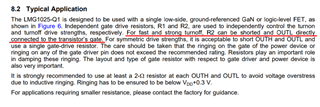Dear TI engineers,
In the datasheet of LMG1025-Q1, R1 and R2 are recommended to be larger than 2 Ohms. For me, the important thing is the rising time, not the falling time.
In this regard, 1) Would using sufficiently large R2 be helpful to reduce ringings if we want to use R1 smaller than 2 ohms?
2) Can R1 be shorted for a fast-rising time as in the case of the shorted R2 for a fast falling in the datasheet? (please see the attached figure)
Thank you very much in advance.
Hoonil Jeong

